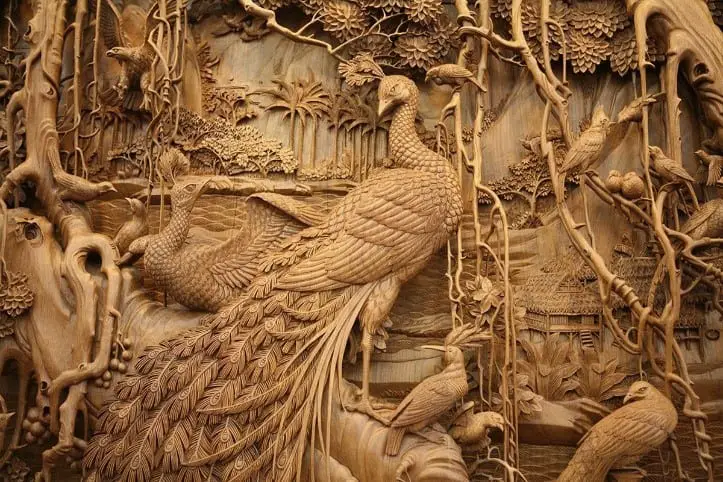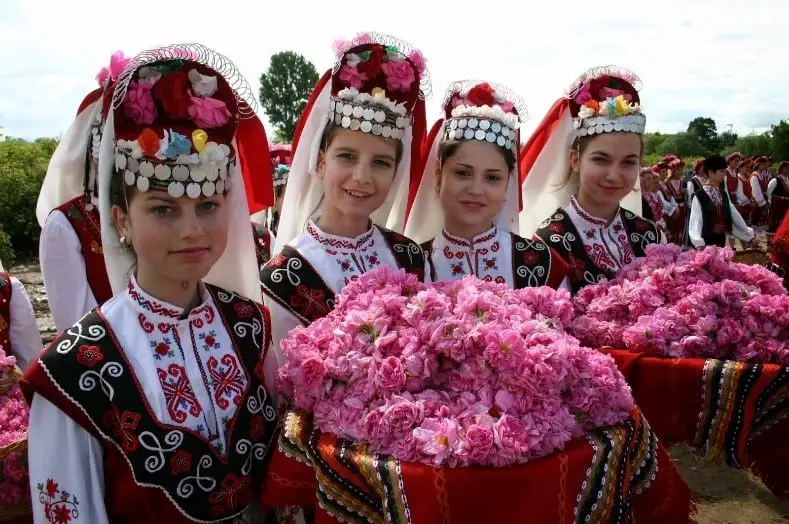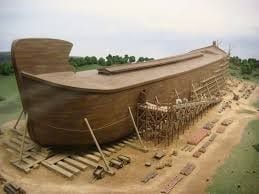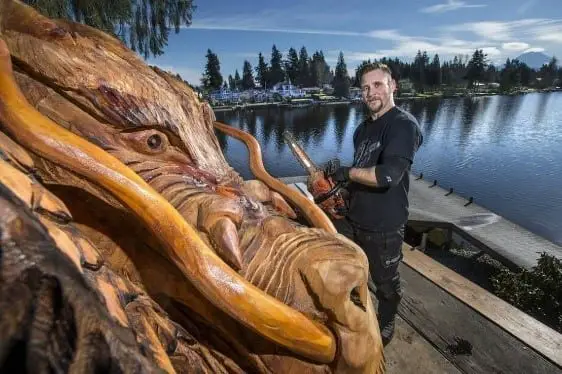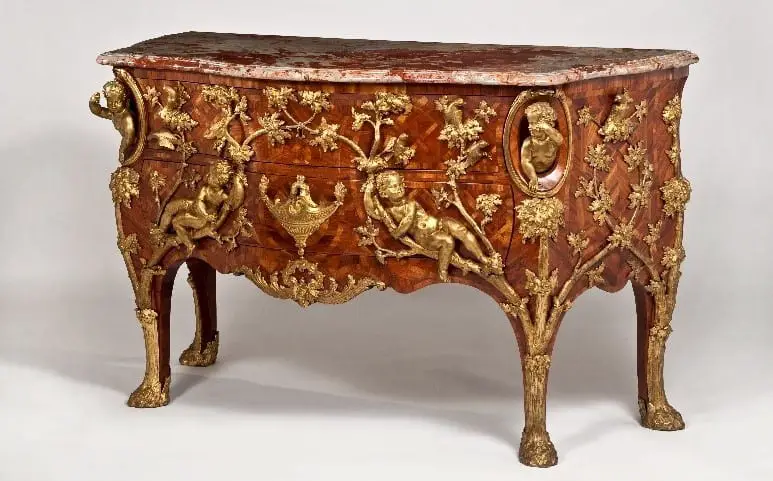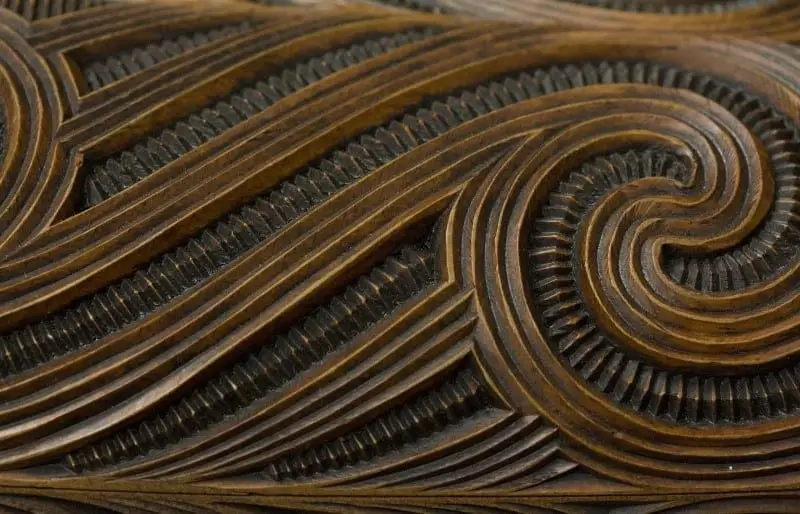
The intricate beauty of Maori wood carving is truly one-of-a-kind.
Thus, it’s hard, if possible at all, to look at a stunning Maori wooden masterpiece and get to confuse it with that of any other nation or mighty civilization world-wide.
The twisted spirals and perfectly symmetrical patterns which curve, twist, and flow give off a particular sense of perfection which allures the eyes and captivates the mind forever.
Simultaneously, this makes you wonder about the thought process behind the creation of Maori’s incredible wood carving designs.
What are the most sacred passion and most intimate beliefs which flowed through the hearts and the hands of the talented Maori woodcarvers?
According to the Maori culture, as one gets to brings life to wood through carving, so does one get the invaluable ability to speak to the people who see his work.
Thereby, Maori’s cultural inheritance is one of ancient history, filled with big dreams, deep beliefs, and incredible achievements.
Most noteworthy, the art of Maori woodcarving is the invisible bridge which connects the legacy of the Maori ancestors with the next generations, transmuting information in a similar way a fairytale does.
Although, with fairy tales, the story is told by mouth while with Maori wood carving – you can first feel the story with your eyes before you hear the meaning behind it.
Video by Overlander – Maori Wood Carving, Te Puia, Rotorua
Source: youtube.com
What is the Meaning of Maori Spirals in the Art of Woodcarving?
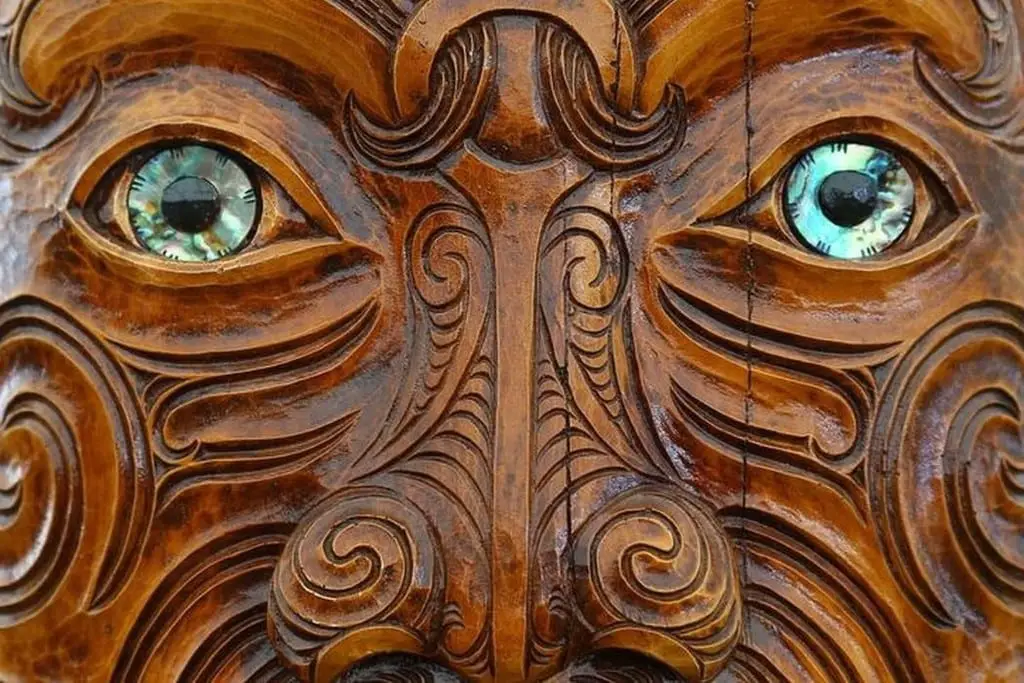
Maori spirals stand for the unique, spiral-shaped symbols which are the signature of Maori art. The native word for these distinctive patterns is koru which translates into “loop.”
The meaning of Maori spirals sums up in 4 words: peace, growth, strength, and new life. Amazingly, Maori spirals mean so much more than what meets the eye.
Amazingly, the Maori spiral as a symbol is based on a naturally existing plant – fern. To illustrate this better, it’s an unfurling fern fond.

According to Te Ahukaramū Charles Royal, who is the moving force behind “Māori creation traditions – Common threads in creation stories”, Te Ara, published in the Encyclopedia of New Zealand – the circular shape “… [] conveys the idea of perpetual movement… [].”
Meanwhile, the inward coil is a symbol of “… [] return to the point of origin… [].”
Thus, when merged together, the meaning of these symbols – the meaning of life itself – is that “… [] life both changes and stays the same… [].”
Interestingly, Maori spirals can be found in the decoration of canoes, houses, and weapons.
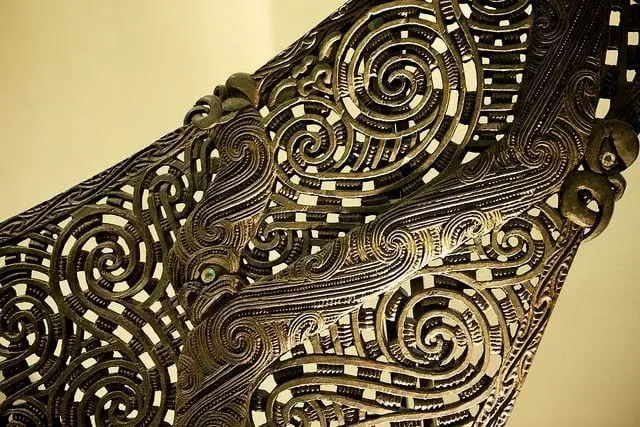
Image Source – An example of a carved prow of Maori canoe
There is a deeply spiritual and symbolic meaning behind the carving of all these objects.
For instance, the Maori warriors used knives with intricately carved wooden handles.
Certainly, the wooden handle helped to improve the grip over the knife. But moreover, it served a protective purpose. In other words, Maori woodcarving is much like a divine blessing for anyone who gets in contact with the masterpieces made out of wood.
But what’s more, in Maori culture, a knife was used for important exchange.
Thus, tribes could exchange knives as a symbol of peace. Nevertheless, the exchange of knives has been used a way to seal a marriage. In fact, trading a knife for something else was also accepted, with the modern-day equivalent of this being currency.
On another note, Maori meeting houses were skillfully and beautifully decorated with wood carvings of different kinds. Of course, Maori spirals were an intricate part of the decoration, too.
But what’s more, a Maori meeting house has a deeply symbolic meaning and is closely related to the spiritual beliefs of the natives.
For a start, a meeting house can belong to a particular family, sub-tribe, or tribe.
These meeting houses are called marae, which actually translated into meeting grounds.
Each marae consists of a carved house. Nevertheless, there is also a special cooking hall, dining room, as well as a toilet and shower zone. Last but not least, there is an open space, as well.
Amazingly, entering a Maori meeting house is like entering another dimension, where each figure speaks without words. For instance, at the very rooftop in front of the house, we can find the carved figure of the tekoteko.
Tekoteko can be seen as a human’s head, while the front bargeboards of the house can be seen as the hands of the tekoteko, greeting the guests and blessing those who enter the house.
Some of the symbols which are incorporated in the woodcarving in meeting houses are related to the genealogy of the tribe. Also, some scenes may come from tales and legends, while others may depict a beloved person who has passed away.
Probably the best way to describe the true meaning of a meeting house is through the Maori word tūrangawaewae. Tūrangawaewae translates into a place to stand and belong.
Video by KoNgatiAwaTeToki – Mātaatua Wharenui – The House That Came Home
Source: youtube.com
How Did the Maori Wood Carving Art Flourish?
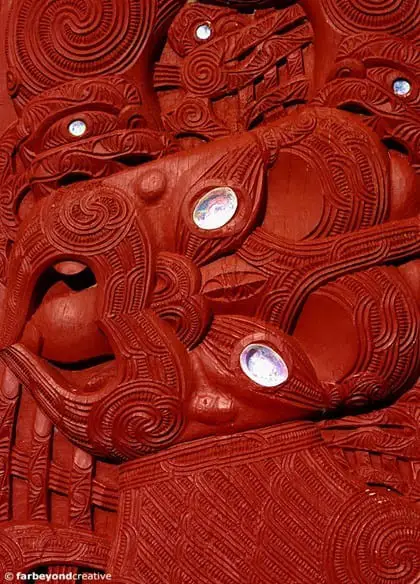
Image Courtesy of far Beyond Creative – Photography and Design – Source
Indeed, there are several key factors which helped Maori wood carving take such a significant part in the life and history of the natives.
Smart carving tools
Maori had access to whao and kuru – chisel and mallet.
As a comparison, ancient Polynesians were much more limited in terms of carving tools. In fact, the experts believe that an unbelievable dose of patience was required in order to carve wood with adzes such as those of the Polynesians.
Phenomenal Local Trees
Much like with the superior carving tools the Maori had access to, the type of local trees also turns out to work in their favor. For example, Polynesian carvers had to deal with wood from cross-grained timber. That inevitably makes the process of wood carving much more elaborate.
But Maori woodcarvers were blessed with the natural abundance of New Zealand’s straight-grained timber. Some examples on that note include the notorious Kauri tree.
Kauri is a type of endemic, ancient wood which was found and harvested from swamps, dating back to hundreds of years ago. Moreover, the natives managed to preserve the natural abundance and harvest of this type of tree.
Other endemic, straight-grained timber includes Totara andKahikatea trees.
The Secret Ingredient: Argillite
Ultimately, Maori also had access to better materials for the purpose of creating woodworking tools. Then again, we can take the Polynesians’ materials for tool making as a comparison.
While the Polynesians were limited to working mostly with limestone and shell basalt, as well as the bad-behaving lava rocks, the Maori reaped the benefits of working with Argillite.
Of course, while these factors might have helped in the robust development the Maori art of wood carving, it would have been impossible without the unique and deep Maori love, respect, and traditions of working with wood.
Which is the Oldest Maori Wood Carving?
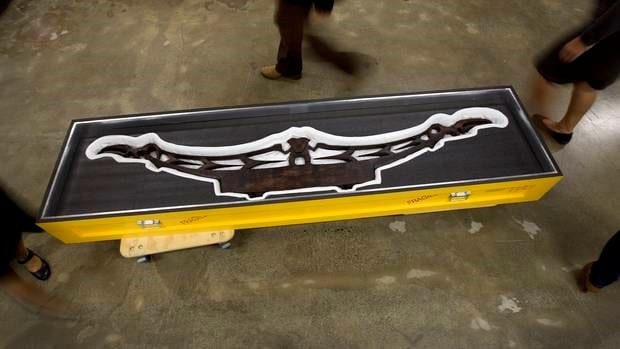
The Oldest Maori carving – the Tangonge. Exhibition: Te Ahu Heritage Centre in Kaitaia. Author of the Photo: Sarah Ivey – Source
For a start, it’s essential to understand that the traditions and secrets of the ancient Maori woodcarving highly depend to being passed from one talented woodcarver to another.
Indeed, wood is a delicate material. It is not like any other material. Thus, it tends to get very hard for masterpieces made out of wood to be well-preserved for a long period.
Although, there are excellent examples of wooden objects dating back to 5000 years ago, the age of the oldest Maori wood carving is much more humble. The Tangonge carving is approximately 600-800 years old.
Surprisingly, it was found at the very bottom of the Tangonge lake, and hence the name. What’s more, the experts had to drain the lake before being able to discover the magnificent Maori carving in 1920.
Amazingly, researchers are still having a hard time deciphering the meaning of the mysterious ancient carving.
There is an intriguing hint, though, which is most probably the key to understanding the meaning and purpose of the Tangonge carving.
The main figure of the carving is that of a human-like being with hands raised upwards. If we look at the top of the carving, it appears as if the hands of the figure are pointing in different directions.
However, if we look at the carving from the front – it appears as if the figure is “gripping” the carving.
Surely, this is an amazing example of the thought process behind Maori wood carving, even though the mystery around the encoded meaning of the carving remains uncovered.
Another of the beautiful Maori spiritual beliefs is that wood has a soul – the soul of a living being – the soul of a tree. Does this sound too spiritual at first? If we get to think of it, nowadays the world needs to find ways of sustainable living more than ever. It seems as if the ancient Maori beliefs end up being a wiser option than the lifestyle we have embraced in modern-day society.
Who Preserves the Traditions of Maori Woodcarving Nowadays?
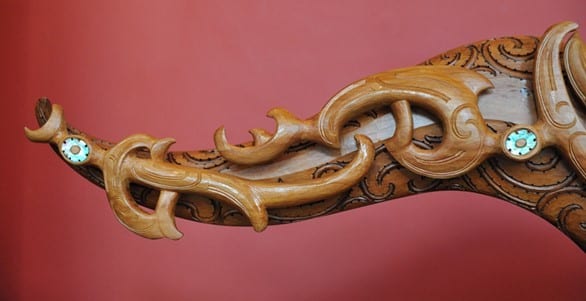
Image Source – An example of a modern-day version of the traditional Maori woodcarving
Happily, the art of Maori wood carving will keep on for as long as the traditions are being transmuted from the senior masters of woodcarving to the young and passionate generations.
For example, New Zealand’s Maori Arts and Craft Institute has announced free hours when visitors can also watch how the young trainees learn from the master woodcarvers in the art of Maori wood carving. That’s possible thanks to the National Wood Carving School (Te Wānanga Whakairo Rākau).
Nevertheless, it’s important to remember that the invaluable cultural inheritance of Maori arts splits into 4 directions, namely:
- Carving
- Weaving
- Painting
- Ta moko (or traditional Maori tattooing)
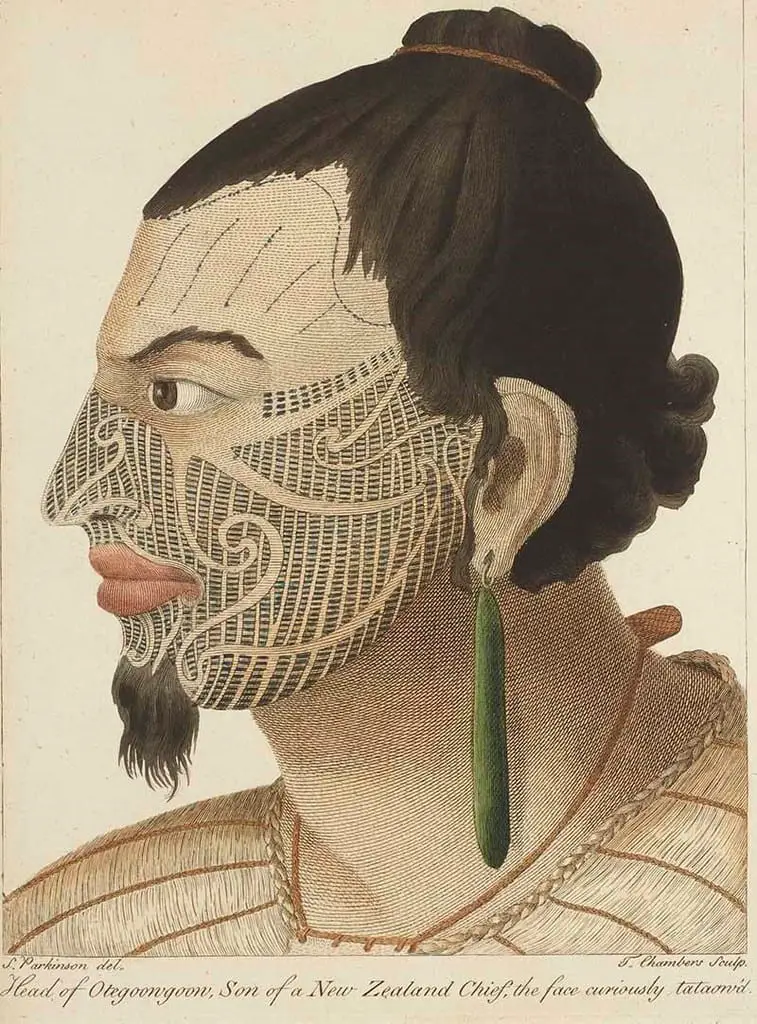
Getting their face tattooed was the path to maturity, as well as one of the spiritual paths for many Maori men
Name of the picture: Head of Otegoowgoow. Son of a New Zealand Chief, the curiously tataoued. Plate 21. From the book: A journal of a voyage to the South Seas, in his Majesty’s ship the Endeavour

Carved guardian representing the Divine realm – Te Whakarewarewa Thermal Reserve – Image Courtesy of Far Beyond Creative – Photography and Design – Source
Fortunately, the country has put huge efforts into the preservation of its cultural treasures when it comes to crafts. In fact, handmade Maori jewelry, carvings, and wall panels are gaining big popularity thanks to the ease of Internet communications and trade.
Furthermore, it’s beautiful to see the Maori traditional arts being able to reach out to so many people globally with their deep meaning and pure blessing.

The art of weaving – Image Source
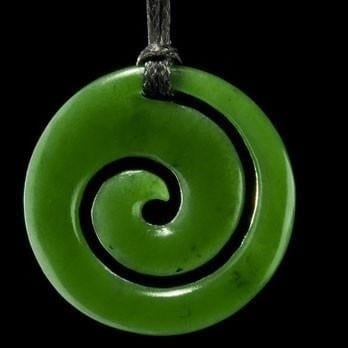
Contemporary Maori Koru jewelry – Image Source
Maori Art of Wood Carving: Final Food for Thought
Above all, the Maori culture is shaped by mesmerizing legends, honesty, deep understanding and respect for Mother Nature, as well as the entire Universe.
It is surely no wonder how the Maori arts were able to travel through time and meet us all the way up in the 21st century. In fact, this may also be the perfect moment of our existence that we need to learn how to be as wise and kind as the Maori to Planet earth.
Just like the ancient Maori proverb goes – Whatungarongaro te tangata toitū te whenua –As man disappears from sight, the land remains.
Maori have a profound and genuine respect for Papatuanuku – The Mother of the Earth. They see the world holistically as a combination of human and natural forces, with the latter being dominant and foundational for our well-being.
Interestingly, Maori proverbs (Whakataukī) were widely used by the natives during speeches, and also as spoken guidelines to help people go through each day with wisdom and love.
Little by little, century after century – the art of Maori woodcarving was passed from one master to another, just like the ancient Maori proverbs traveled through space and time.
And indeed, we can consider ourselves lucky for being able to enjoy such an abundance of cultural inheritance globally, with the art of Maori woodcarving sparkling an immortal flame through the history of humankind and boundless creativity.

